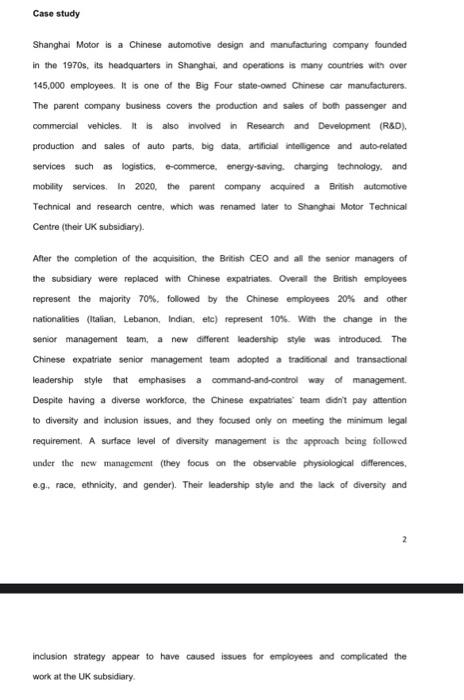Case study Shanghai Motor is a Chinese automotive design and manufacturing company founded in the 1970s, its headquarters in Shanghai, and operations is many countries with over 145,000 employees. It is one of the Big Four state-owned Chinese car manufacturers. The parent company business covers the production and sales of both passenger and commercial vehicles. It is also involved in Research and Development (RsD). production and sales of auto parts, big data, artificial intellgence and auto-related services such as logistics, e-commerce, energy-saving. charging technology. and moblity services. In 2020, the parent company acquired a British automotive Technical and research centre, which was renamed later to Shanghai Motor Technical Centre (their UK subsidiary). After the completion of the acquisition, the British CEO and all the senior managers of the subsidiary were replaced with Chinese expatriates. Overall the British employees represent the majority 70%. followed by the Chinese employees 20% and other nationalities (Italian, Lebanon, Indian, etc) represent 10\%. We the change in the senior management team, a new different leaderahip style was introduced. The Chinese expatriate senior management team adopted a tradifional and transactional leadership style that emphasises a command-and-control way of management. Despite having a diverse workforce, the Chinese expatriates' team didn't pay attention to diversity and inclusion issues. and they focused only on meeting the minimum legal requirement, A surface level of diversity management is the approach being followed under the new management (they focus on the observabie physiological diflerences, e.g. race, ethnicity, and gender). Their leadership style and the lack of diversily and inclusion strategy appear to have caused issues for employees and complicated the work at the UK subsidiary. Q5. A. Critically analyse the changing impact and challenges of globalisation on IHRM practices within organisations. (LO1) B. Discuss the convergence and divergence approaches to international HRM and the factors affecting the choice between them. (LO1)








